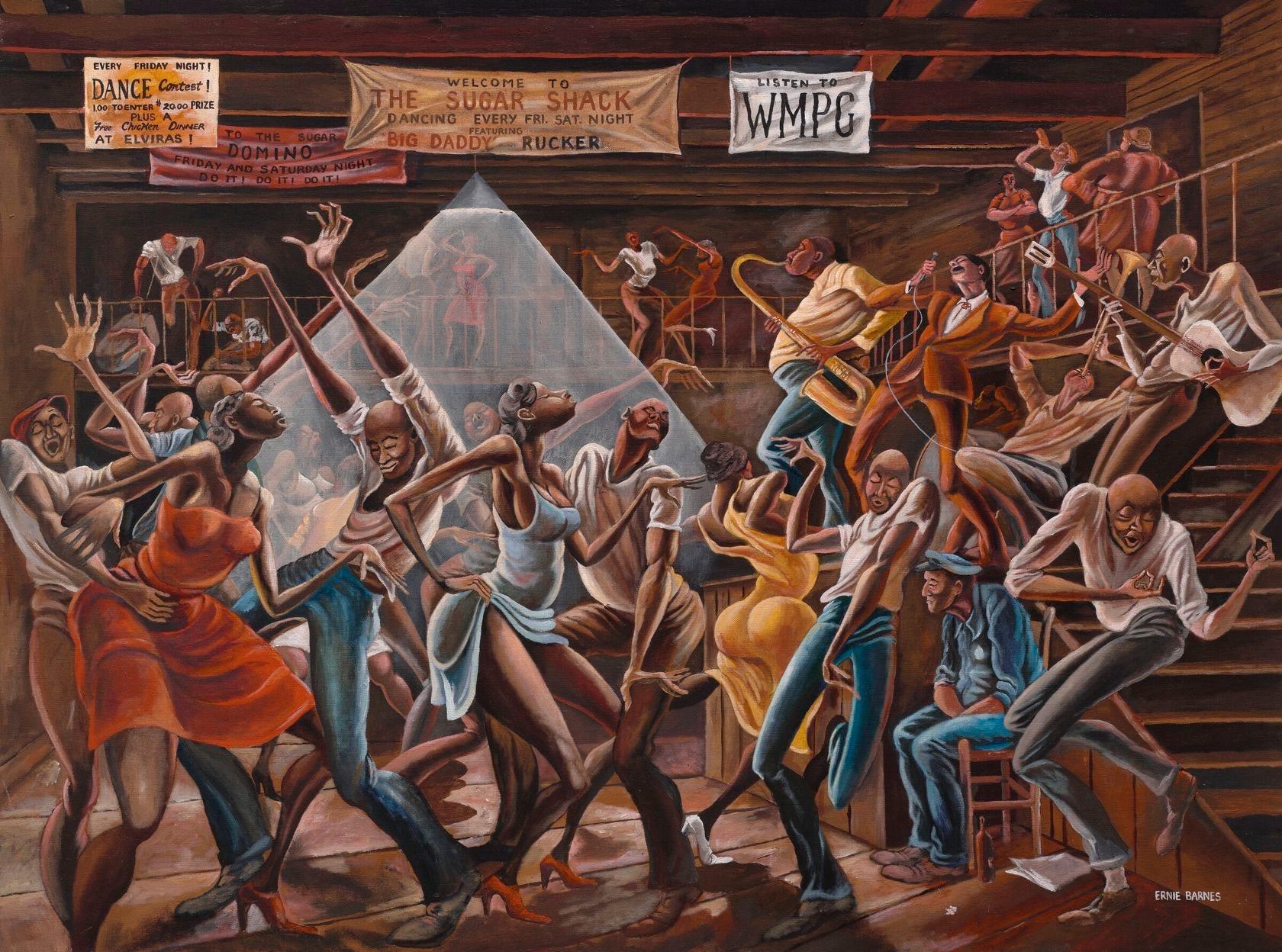"The Sugar Shack: Where We Dance Our Truths"
In a time when the world outside offered little space for joy, The Sugar Shack became a sanctuary. Tucked away in a weathered part of town, it pulsed with rhythm, sweat, and life. Every Friday and Saturday night, men and women left behind the burden of the week's labor, the weight of societal judgment, and the sting of inequality — to dance.
Here, no one cared about your job, your title, or your troubles. The dance floor was a sacred ground of self-expression. Twisting bodies and stretched limbs told stories no words could. Laughter erupted louder than the music. Eyes sparkled with resilience. The saxophone cried, the guitar testified, and the people — oh, the people — lived.
But look closer. Beyond the joy, there's something more profound.
There’s the old man sitting alone in the corner — a past generation watching a new one define its own identity. There’s the exaggerated motion of limbs — almost cartoonish — suggesting a hunger for freedom too large for the real world to contain. The light in the center beams down not just to illuminate the dancers, but to symbolize something divine in their defiance: freedom through joy, unity through rhythm, identity through culture.
Teachable Lesson:
The Sugar Shack reminds us that in a society that often devalues or misrepresents Black culture, spaces of joy and expression are revolutionary.
It teaches us:
That art is a protest, not just in silence, but in celebration.
That community joy is sacred, and resilience can take the form of dance, laughter, and music.
That sometimes, the loudest resistance is to live freely despite it all.
A Mirror for Society:
Are we creating spaces where everyone is free to dance their truths?
Or are we still judging, limiting, and excluding based on background, color, or class?
The Sugar Shack holds up a mirror and asks:
"What would your dance look like, if no one was watching — and you were finally free?"
In a time when the world outside offered little space for joy, The Sugar Shack became a sanctuary. Tucked away in a weathered part of town, it pulsed with rhythm, sweat, and life. Every Friday and Saturday night, men and women left behind the burden of the week's labor, the weight of societal judgment, and the sting of inequality — to dance.
Here, no one cared about your job, your title, or your troubles. The dance floor was a sacred ground of self-expression. Twisting bodies and stretched limbs told stories no words could. Laughter erupted louder than the music. Eyes sparkled with resilience. The saxophone cried, the guitar testified, and the people — oh, the people — lived.
But look closer. Beyond the joy, there's something more profound.
There’s the old man sitting alone in the corner — a past generation watching a new one define its own identity. There’s the exaggerated motion of limbs — almost cartoonish — suggesting a hunger for freedom too large for the real world to contain. The light in the center beams down not just to illuminate the dancers, but to symbolize something divine in their defiance: freedom through joy, unity through rhythm, identity through culture.
Teachable Lesson:
The Sugar Shack reminds us that in a society that often devalues or misrepresents Black culture, spaces of joy and expression are revolutionary.
It teaches us:
That art is a protest, not just in silence, but in celebration.
That community joy is sacred, and resilience can take the form of dance, laughter, and music.
That sometimes, the loudest resistance is to live freely despite it all.
A Mirror for Society:
Are we creating spaces where everyone is free to dance their truths?
Or are we still judging, limiting, and excluding based on background, color, or class?
The Sugar Shack holds up a mirror and asks:
"What would your dance look like, if no one was watching — and you were finally free?"
"The Sugar Shack: Where We Dance Our Truths"
In a time when the world outside offered little space for joy, The Sugar Shack became a sanctuary. Tucked away in a weathered part of town, it pulsed with rhythm, sweat, and life. Every Friday and Saturday night, men and women left behind the burden of the week's labor, the weight of societal judgment, and the sting of inequality — to dance.
Here, no one cared about your job, your title, or your troubles. The dance floor was a sacred ground of self-expression. Twisting bodies and stretched limbs told stories no words could. Laughter erupted louder than the music. Eyes sparkled with resilience. The saxophone cried, the guitar testified, and the people — oh, the people — lived.
But look closer. Beyond the joy, there's something more profound.
There’s the old man sitting alone in the corner — a past generation watching a new one define its own identity. There’s the exaggerated motion of limbs — almost cartoonish — suggesting a hunger for freedom too large for the real world to contain. The light in the center beams down not just to illuminate the dancers, but to symbolize something divine in their defiance: freedom through joy, unity through rhythm, identity through culture.
Teachable Lesson:
The Sugar Shack reminds us that in a society that often devalues or misrepresents Black culture, spaces of joy and expression are revolutionary.
It teaches us:
That art is a protest, not just in silence, but in celebration.
That community joy is sacred, and resilience can take the form of dance, laughter, and music.
That sometimes, the loudest resistance is to live freely despite it all.
A Mirror for Society:
Are we creating spaces where everyone is free to dance their truths?
Or are we still judging, limiting, and excluding based on background, color, or class?
The Sugar Shack holds up a mirror and asks:
"What would your dance look like, if no one was watching — and you were finally free?"


·435 Views
·0 Anteprima
